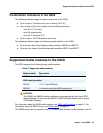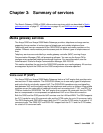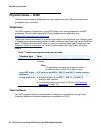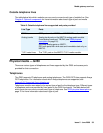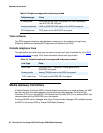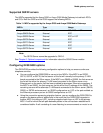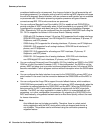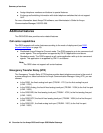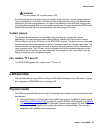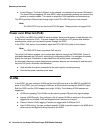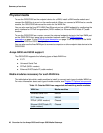
Summary of services
42 Overview for the Avaya G250 and Avaya G350 Media Gateways
considered stable and is not preserved. Any change of state in the call prevents the call
from being preserved. For example, putting a call on hold during MGC migration will cause
the call to be dropped. Special features, such as conference and transfer, are not available
on preserved calls. Connection preserving migration preserves all types of bearer
connects except BRI. PRI trunk connections are preserved.
● You can configure Standard Local Survivability (SLS) to enable a local G250/G350 to
provide a degree of MGC functionality when no link is available to an external MGC. SLS
is configured on a system-wide basis using the Provisioning and Installation Manager
(PIM). Alternatively, SLS can be configured from the individual G250/G350 itself using the
CLI. SLS is supported as follows in the various Branch Gateway models:
- G350 with C/S (hardware vintage) 3.0 and up: SLS supported for all analog interfaces,
ISDN BRI/PRI trunk interfaces, non-ISDN digital DS1 trunk interfaces, IP phones, IP
Softphone, and DCP phones.
- G250-Analog: SLS supported for all analog interfaces, IP phones, and IP Softphone.
- G250-BRI: SLS supported for all analog interfaces, ISDN BRI trunk interfaces, IP
phones, and IP Softphone.
- G250-DCP: SLS supported for all analog and DCP interfaces, IP phones, IP
Softphone, and DCP phone.
- G250-DS1: SLS supported for all analog interfaces, ISDN PRI trunk interfaces,
non-ISDN digital DS1 trunk interfaces, IP phones, and IP Softphone.
● You can configure Enhanced Local Survivability (ELS) by installing an S8300 in the G250/
G350 as a Local Survivable Processor (LSP). In this configuration, the S8300 is not the
primary MGC but takes over to provide continuous telephone service if all external MGCs
become unavailable. Calls in progress continue without interruption when the S8300 takes
over.
● You can configure the dialer interface to connect to the G250/G350’s primary MGC via a
serial modem in the event that the connection between the G250/G350 and the MGC is
lost.
● You can configure the Avaya CM to support the auto fallback feature, which enables a
G250/G350 being serviced by an LSP to return to its primary MGC automatically when the
connection is restored between the G250/G350 and the MGC. When the G250/G350 is
being served by its LSP, it automatically attempts to register with its MGC at periodic
intervals. The MGC can deny registration in cases in which it is overwhelmed with call
processing, or in other configurable circumstances. By migrating the G250/G350 to the
MGC automatically, a fragmented network can be unified more quickly, without the need
for human intervention.
Note:
Note: Auto fallback does not include survivability. Therefore, there is a short period
during registration with the MGC during which calls are dropped and service is
not available. This problem can be minimized using the connection preserving
migration feature.




